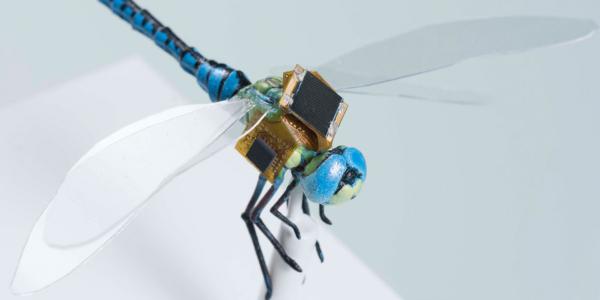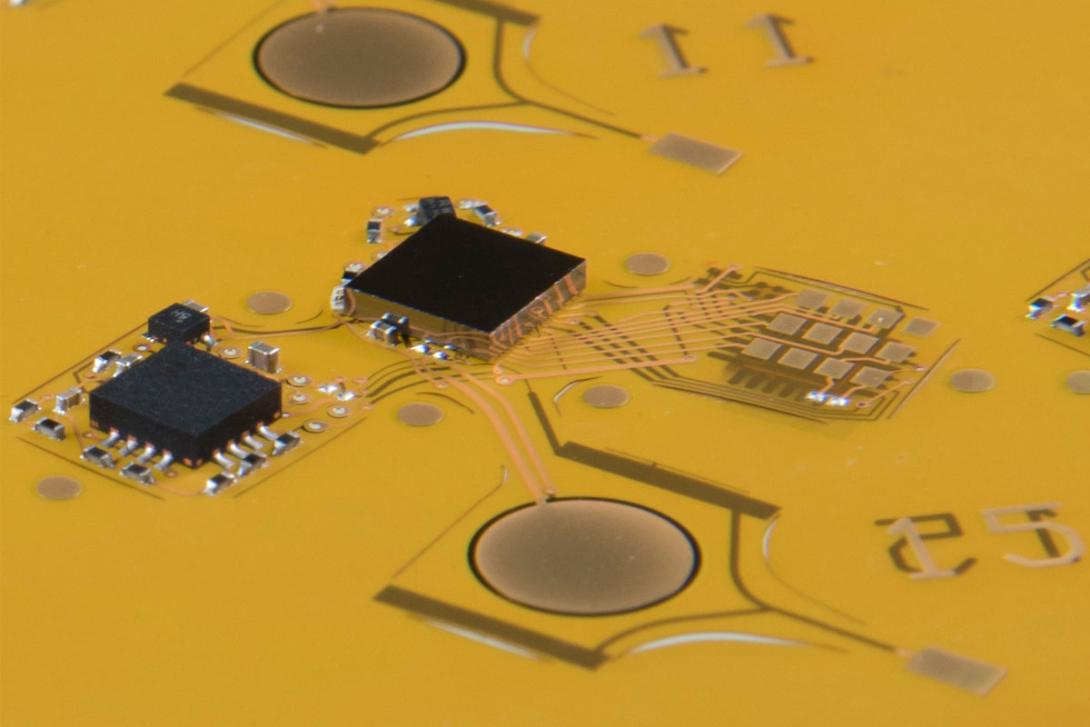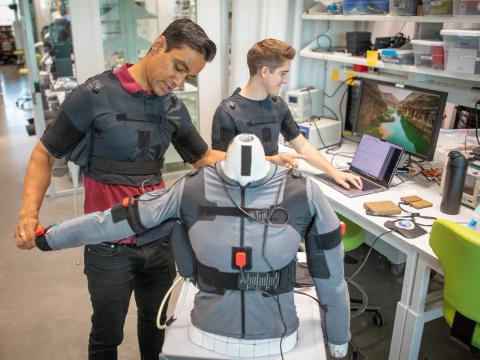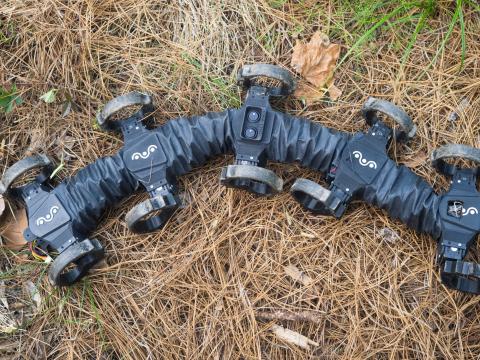I Spy With My Cyborg Dragonfly
Researchers are planning the inaugural test flight of a cyborg dragonfly, a brand-new type of micro aerial vehicle. Harnessing the power of nature, the hybrid system is smaller, lighter and stealthier than most man-made systems and could prove valuable for military reconnaissance and a variety of other missions.
Scientists with The Charles Stark Draper Laboratory Inc., Cambridge, Massachusetts, and the Howard Hughes Medical Institute (HHMI), Ashburn, Virginia, are partnering on a Draper-funded project known as DragonflEye.
The researchers have developed a small electronic backpack that can be attached to a living dragonfly. If successful, the backpack will be used to control the insect’s flight.
Research by the HHMI’s Anthony Leonardo has led to a deeper understanding of the dragonfly’s neurons used for steering and flight control. The HHMI is applying techniques in synthetic biology to make the steering neurons sensitive to light by inserting genes similar to those naturally found in the eye.
Meanwhile, Draper is developing tiny optical structures called optrodes, which can activate the steering neurons with pulses of light piped into the nerve cord from the dragonfly’s backpack. Traditional optical fibers are too stiff to be wrapped around the tiny dragonfly nerve cord, so Draper developed flexible optrodes that can bend light around submillimeter turns, enabling precise and targeted neural activation without disrupting thousands of nearby neurons.
“These steering neurons are kind of like a joystick. We believe they’re sending out a command to move to the left, but then there are a bunch of other neurons ... that actually control the muscles that control the wings and maintain stable flight,” explains Jesse Wheeler, a Draper Labs biomedical engineer and principal investigator on the project.
Although neurons can be stimulated using electricity, that is not a viable option when dealing with an insect-size nervous system. The steering neurons are in a tiny nerve cord about 250-300 microns in diameter. “You can’t inject a small enough amount of current in a very precise way to activate just those neurons. It would be kind of like going into the wing of a jet and activating all the electronics on and off at the same time,” Wheeler elaborates.
Optogenetics offers a much greater degree of precision. “We can modify just those 16 neurons and only those 16 neurons, so that means now we can stimulate those selectively and have the potential to guide the direction of flight,” Wheeler reports.
The dragonfly offers advantages over man-made systems in part because the rules of aerodynamics are notoriously unpredictable at micro levels, creating challenges for mechanical systems. Furthermore, mechanical technologies must carry a power source—namely batteries—which presents additional flight challenges and limits the time they can remain in the air.
“The insects are far more efficient at producing lift with their wings. They can store energy. As long as there’s a food source, they can continue to eat and fly,” Wheeler says.
He lists some other pluses of the bionic bugs. “The dragonfly is an amazing flyer. It’s much smaller than a hummingbird, for example. Hummingbirds can hover, and so can dragonflies, but dragonflies can go upside down. They can reach accelerations up to nine G’s,” Wheeler says, referring to the gravitational force of flight acceleration.
Although he has not witnessed it personally, Wheeler says others have reported dragonflies reaching flight speeds of 25 or 30 mph. “That’s pretty impressive for such a small little guy,” he says.
Additionally, thanks to research at the HHMI, the dragonfly’s rather simple nervous system is well-understood. “The dragonfly, we believe, will be much easier to control because its nervous system is small enough that it has been well-studied. We know what we should be targeting precisely,” Wheeler offers.
This summer, the research team will take a first step toward testing its prototype backpack technology. The inaugural test flight will occur in the HHMI’s synthetic environment—a dragonfly heaven in which the grass is always green and the sun perpetually shines. “We’re now at a point where we’ve got our first-generation backpack complete. We can put that onto the dragonfly, and we can start developing our tracking algorithms,” Wheeler reveals.
Joe Register, Draper’s technical director on the DragonflEye program, describes the upcoming experiment as a wireless test. “We’re going to use our communications and our onboard navigation sensors,” Register states. “The first experiment is really just navigation data. We’re verifying that the payload we’ve created is of the right weight and has the right data points and the right update rates.”
The data provided by the electronic backpack will be compared with the location and navigation information provided by a number of cameras within the synthetic environment. “The first step is to make sure we can accurately track its trajectory. We will not be trying to change its trajectory,” Wheeler adds.
If that experiment goes well, it may be another year before the team tries to control the cyborg’s flight, and advances could happen pretty quickly after that, the researchers predict. “The major milestone we’re aiming for is to first change the flight of the dragonfly using stimulation. I would imagine that when that first happens, the steering may not be very precise—meaning that we’ll learn if we can just get it to the left or right or up or down,” Wheeler suggests.
The team likely will spend another year refining the controls. “At that point, we can really start exploring the applications that we want to go after. Of course, it will take even more time to refine the system for any specific application,” Wheeler says.
Potential applications include military reconnaissance or search and rescue missions. Perhaps less obvious are the possible medical applications. The flexible optrodes that deliver light signals to the dragonfly’s steering neurons could be adapted to enable miniaturized diagnostics or to precisely deliver medicine.
One reason pharmaceutical products often have side effects, Wheeler points out, is that the chemicals diffuse throughout the body. “An alternative approach that offers much greater specificity is to activate the neurons that go to those organs,” he offers. “The idea is that by stimulating those neurons, you can then affect the end-organ function, and that’s much more specific because you’re only affecting the neurons that you care about.”
Optogenetics offers advantages over electrical stimulation in the medical world as well. “Electricity turns on the neurons. With light, you can actually turn them on and turn them off using different colors of light,” Wheeler adds. “Electrical stimulation is where we are now in current-day bioelectronics medicine, but we think the future will be in optogenetics. We think that we’re opening up a huge field of opportunities.”
The technology might even be used for bees, aiding them in their environmental mission. The world’s bee population has been diminishing, raising concerns. “One of the things we’re interested in is the ability to pollinate,” Wheeler says. “You might want to put a sensor on the bees to sense the environment around them. Maybe it’s the temperature, or maybe it’s a chemical that they’re coming into contact with in the environment.”
The Draper-HHMI team is not the first to develop cyborg insects. Scientists at North Carolina State University in Raleigh have developed an electronic backpack for Madagascar hissing cockroaches. In that case, the backpack includes electrodes attached to the bug’s antennae and abdomen.
Wheeler explains, however, that his team’s approach is fundamentally different from those taken by other research groups. One common tactic with other insects, for example, is to spoof the sensor input to make the insect think it is moving a certain direction so that it responds and moves in the other direction. The effect could be compared to that caused when a person on a train sees the train next to his begin to leave the station and momentarily misunderstands which train is moving. Wheeler questions whether that technique will be successful over time because the insects could simply begin ignoring the incoming signals.
Besides, it is just not nice to fool Mother Nature. “We think long term, spoofing sensory input is very challenging,” Wheeler says.
Another approach directly stimulates the neurons controlling the insect’s muscles. “It’s very difficult to maintain stable flight when you’re trying to control the wings directly,” Wheeler states, adding that evolution already has created an effective flight control system for insects. “Thinking that we’re going to come in and be better than that is a big task.”






Comments